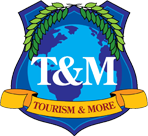The Anaheim Study
March 2004
The Southern California Tourism Safety & Security Association, in conjunction with the Anaheim/Orange County Visitor & Convention Bureau, recently completed a major field survey on the topic of visitor attitudes on tourism surety (safety and security). Although the study, like almost all tourism studies, can be classified as a convenience sample, the study’s sheer size, with over 4,000 visitors sampled, tells us a lot about how visitors to Anaheim view tourism surety. Because this is such an important and large study, Tourism Tidbits is pleased to bring to the tourism and visitor professional some of the study’s major findings. The complete study called “Visitor Attitudes Concerning Safety & Security” will be published in March, and will be discussed in detail at the 5th annual California Tourism Safety & Security Conference on March 25th at the Hilton Anaheim.
Over 3,000 face-to-face interviews with travelers were conducted at various southern California tourist venues, including airports, theme parks and pedestrian malls. The questions focused on the role safety & security concerns play in selection of a travel destination, hotel, amusement park, and convention center, and also how a visible police and security presence impacts visitors.
For those people interested in methodology, the survey used a “1 – 10″ perceptual rating scale, in which respondents indicate how strongly they felt about each issue. The study divides respondents along tourist demographic lines: international, domestic, local, and those visitors traveling for business or conventions. Here are some of the survey’s major results.
- Visitors reported that safety & security is a top factor in selecting their destinations. Of those participating in the survey some 55% responded that safety & security was the most important factor, giving it the highest rating of “10.” The average recorded rating was “8.9.” As has been noted in other studies, international visitors rated tourism surety even higher, with an average score of “9.3.” What this means is that destinations that desire to compete in the 21st century will need to include a tourism security component in their marketing. Tourism and travel officials are making a major mistake if they divorce their police departments from their tourism promotion efforts and fail to provide TOPs (tourism oriented police services) training.
- The same factor reappeared when travelers were asked about hotel security/safety. The average rating here was “9.1″ with 61% of all respondents giving it a “10.” Of the four locations asked about in this survey (destination, hotel, amusement park, convention center), hotels ranked highest for safety & security concerns. This result ought to be a wake up call to GMs. Those places of lodging that give security a high priority are positioning themselves for economic success for the foreseeable future. Those places of lodging that choose to ignore security concerns are risking not only legal action but also risk losing money.
- Respondents made it clear that, in this “era of terrorism” and in places where there is street crime, a highly visible police and security presence makes them feel more comfortable. The average rating on this point was “8.6″ and 50% of visitors ranked it a “10.” One only need to go to New York City to see how a viable police presence can change the entire personality of a city.
Although not part of the study, these results ought to inspire tourism and travel professionals to follow some of the following Tourism & More guidelines:
- Attend one of the tourism security conferences around the world. This year there will be the one day conference in Anaheim (March 25) the three day International Tourism Security Conference in Las Vegas (May 10-12), and additional conferences this summer in the Pacific region and possibly in Brazil. Conference times and places are listed below.
- Encourage your police department to take a tourism security course. Most police officers have never studied TOPs and need to be given the opportunity to recognize a whole new concept of pro-active policing as a form of economic development.
- Integrate a representative of the police department into the CVB’s board. Police departments all too often complain that they are notified of major tourism events only at the last moment.
- Develop dialogue opportunities where hoteliers, restaurateurs and law enforcement can come together and discuss future oriented security concerns.
- Develop a security brochure. Include in this brochure basic safety features and emergency phone numbers. When designing your brochure consider using bright and cheerful colors with clear and easy to read fonts placed on a background of colors that are upbeat and encouraging. Design these guides so as the reader receives the subtext that although caution is critical, your community is still a safe and fun place to visit.
- Consider developing, along with your local police department and Hotel/Motel Association, a security rating system. Most police departments are happy to help a local HMA develop an overall security plan. Once the plan is written, ask your HMA to accredit its members as to security readiness. Such a program helps both hoteliers and guests.
- Remember that when new hotels are being constructed, emphasize CPTED: “Crime Prevention Through Environmental Design.” This is a very successful crime fighting method that most people will never notice. For example, ask if your locale’s hotels have physical boundaries, what type of lighting do they use, how safe are their parking areas?



